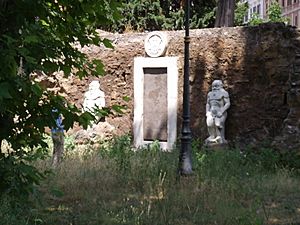Porta Alchemica facts for kids
The Porta Alchemica (which means Alchemical Door in English), also known as the Alchemy Gate or Magic Portal, is a very old monument in Rome, Italy. It was built a long time ago, between 1678 and 1680, by a nobleman named Massimiliano Palombara. He had it built at his home, the Palombara villa, which was located on the Esquilino hill in Rome. Today, the gate stands near Piazza Vittorio.
The Porta Alchemica is special because it's the only gate left from the five gates that once belonged to the Palombara villa. There were also four other mysterious writings on the walls inside the villa, but they are gone now.
Contents
The Legend of the Magic Door
There's a cool story about the Porta Alchemica from 1802. It says that a traveler, who was an alchemist named Giustiniani Bono, stayed at the villa one night. He was looking for a special plant that could help him make gold.
The next morning, the story goes, he vanished through the door! But he left behind some gold flakes, showing he had successfully turned something into gold. He also left a mysterious paper filled with puzzles and magic symbols. People believed this paper held the secret to the Philosopher's Stone, a legendary item that could turn ordinary metals into gold and grant eternal life.
Marquis Palombara was very interested in alchemy. He decided to carve the symbols and riddles from the alchemist's paper onto the five gates of his villa and on the walls inside. He hoped that one day, someone would be able to understand them and unlock the secret.
History of the Alchemical Gate
Marquis Palombara's interest in alchemy likely grew when he spent time at the court of Queen Christina of Sweden in Rome, starting in 1656. Queen Christina had given up her throne in Sweden and lived in Rome from 1655 until she passed away in 1689.
Queen Christina had her own alchemy lab at her palace. Many interesting people visited her lab, including experts in hidden knowledge like Giuseppe Francesco Borri and the famous scholar Athanasius Kircher. Kircher even owned the mysterious Voynich manuscript, a book full of strange writings and symbols.
Some people believe that the Porta Alchemica was built in 1680 to celebrate a successful alchemy experiment that happened in Queen Christina's lab.
Between 1678 and 1680, Borri (who was also known as Giustiniani Bono, the alchemist from the legend) worked with Athanasius Kircher on building the Porta Alchemica at Palombara's villa. It's even said that Gian Lorenzo Bernini, a very famous architect and a friend of Kircher, helped design the door. The door was meant to show the secret formula for making gold, which was supposedly discovered in Queen Christina's lab around that time.
The secret of the Philosopher's Stone was eventually lost. Some say it was because Marquis Palombara, Bernini, and Athanasius Kircher all passed away around November 1680.
A Mysterious Symbol
The special design at the top of the Porta Alchemica, with two triangles overlapping and Latin words, looks almost exactly like a drawing found in an old alchemy book. This book is called Aureum Seculum Redivivum by Henricus Madatanus. The design that inspired Marquis Palombara appeared in a later edition of the book from 1677.
This same drawing also appeared in a bookmark owned by Berenger Saunière, a priest who lived in France in the late 1800s. The phrase Aureum Seculum Redivivum (which means "Golden Age Revived") is similar to the motto Novus Ordo Seclorum ("New Order of the Ages") found on the Great Seal of the United States. This motto was also used by a group called the Bavarian Illuminati, who were connected to the Rosicrucianism movement from the 1600s.
Images for kids



